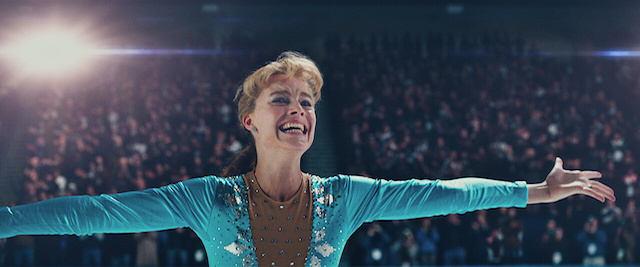
Think of I, Tonya as the Wicked of figure skating. In that musical, the villainous Wicked Witch of the West is reimaged as a sympathetic figure. Similarly, in I, Tonya, we get a Tonya Harding-centric view of both the skater’s troubled life and the infamous Nancy Kerrigan knee-bashing incident that brought Tonya down.
The film, directed by Craig Gillespie in mockumentary style—and based at least partly on actual interviews of Harding and her estranged husband Jeff Gillooly—has much to recommend. It’s a trenchant indictment of the figure skating circuit, which judged Tonya—with her tacky clothes, heavy metal skating songs, and badly teased hair—as unfit for their rarefied world. It has a snappy, rib-nudging style that is undeniably fun to watch. And it features a wonderfully funny and sensitive lead performance by Margot Robbie, who shows us the vulnerability beneath Harding’s defiant bravado. The blissed out smile on Tonya’s face when she becomes the first female skater to land the triple axel in competition—a “no one can take this moment away from me” expression of pure joy—is the image from the film that will stay with me most.
But there’s lots that irked me about I, Tonya, too. For starters, the film has a very ambivalent relationship to Tonya’s abuse. You see, Tonya wasn’t just abused by the skating world, she was abused at home—first by her mean old mother (Alison Janney, with unflattering glasses and a parrot on her shoulder, in a much-praised performance that I found too broad) and later by her jerk of a husband. The film doesn’t shy away from showing the abuse, often wielding it for shock value. In one segment—indicative of the film’s aggressively winking style—Tonya gets shot by her husband, although only grazed, and as he frantically drives her to the hospital, Al Green’s “How Can You Mend a Broken Heart?” is played. Irony!
The character of Jeff Gillooly, often seen side-by-side with Tonya giving his version of the story, is another concern. Gillooly denies that he was abusive, and questions Tonya’s “facts” at every turn. As played by Sebastian Stan, he’s sheepish and a little sweet; it’s hard to imagine him being a monster. So how are we to feel about him? The film literally shows him striking Tonya, but also wants to play it coy, leaving just a tiny bit of room for doubt. All truth is subjective, the film constantly reminds us.
Likewise, the film goes through great pains to suggest that Tonya was essentially innocent of the Nancy Kerrigan attack—that the whole thing was a prank gone horribly wrong, orchestrated by Jeff’s slovenly, goonish friend, Shawn (Paul Walter Hauser, in a series of stained, ill-fitting tee-shirts, another too-broad depiction). But who’s to really know, right? Wink, wink. (It’s especially difficult to ascertain the truth since, curiously, Nancy Kerrigan is all but invisible in the film.)
There’s a moment toward the end of I, Tonya where Tonya faces the camera and judges those of us in the audience. “It was like being abused all over again, only this time it was by you,” she says, of the aftermath of the Kerrigan incident, when she was roundly mocked on late night TV and shunned by society. “. . . You’re all my attackers, too.”
But again and again, the film wants it both ways: To show the abuse, but suggest that it maaaybe didn’t happen that way. To have fun with Tonya and her grotesque mother and her husband’s dim-witted friends and then judge us for judging them. Sorry, I, Tonya, but I’m judging you harder.
